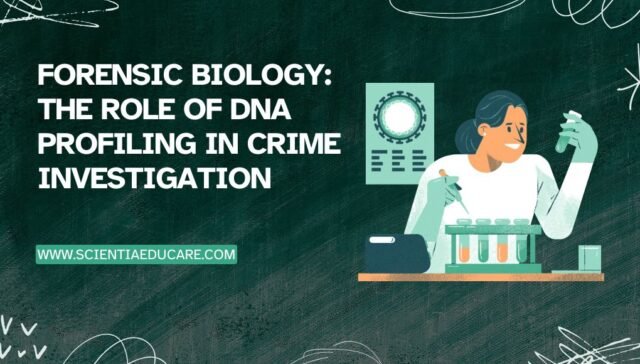Forensic Biology: The Role of DNA Profiling in Crime Investigation
Introduction to Forensic Biology and DNA Profiling
Forensic biology is a crucial branch of forensic science that involves analyzing biological evidence to solve crimes. Among various forensic techniques, DNA profiling is one of the most powerful tools used to identify individuals and establish connections between suspects, victims, and crime scenes. This study module explores DNA profiling, its role in crime investigations, and its impact on the justice system.
How forensic biology solves crimes,
DNA profiling in criminal justice,
Low-cost forensic DNA testing,
Role of DNA in investigations,
Scientific methods in crime detection.
What is DNA Profiling?
DNA profiling, also known as DNA fingerprinting, is a technique used to identify individuals based on their unique genetic makeup. It is widely employed in criminal investigations, paternity disputes, and missing person cases. This method involves analyzing short tandem repeats (STRs) within the DNA to create a genetic profile that is highly specific to an individual.
The Process of DNA Profiling
DNA profiling follows a structured approach to ensure accuracy and reliability in forensic investigations. The key steps include:
- Collection of Biological Samples
- Blood, saliva, semen, hair, skin cells, or bone fragments are collected from the crime scene, victim, or suspect.
- Samples are stored properly to prevent contamination and degradation.
- DNA Extraction
- Cells are broken open to release DNA.
- Various techniques, such as organic extraction and Chelex extraction, are used to purify the DNA.
- DNA Amplification via PCR (Polymerase Chain Reaction)
- The extracted DNA is amplified using PCR to create multiple copies of the target DNA regions.
- STR markers are amplified for forensic comparison.
- Separation and Analysis using Electrophoresis
- Capillary electrophoresis is commonly used to separate DNA fragments based on size.
- The unique STR patterns are analyzed to create a DNA profile.
- Comparison and Database Matching
- The DNA profile is compared with known samples and forensic databases such as CODIS (Combined DNA Index System).
- A match can provide crucial evidence linking a suspect to a crime scene.
- Interpretation and Reporting
- Forensic experts interpret results based on statistical analysis.
- A DNA report is generated and presented in court as evidence.
Applications of DNA Profiling in Crime Investigation
DNA profiling plays a pivotal role in modern criminal justice systems. Its applications include:
- Identifying Suspects and Victims
- DNA evidence can confirm the presence of a suspect at a crime scene.
- Unidentified remains can be matched with missing persons’ DNA.
- Exonerating the Innocent
- Wrongful convictions can be overturned through post-conviction DNA testing.
- Solving Cold Cases
- Old unsolved cases can be revisited using advanced DNA technology.
- Linking Crimes to Serial Offenders
- DNA databases help track repeat offenders by matching DNA from multiple crime scenes.
Challenges and Limitations of DNA Profiling
Despite its effectiveness, DNA profiling has several challenges:
- Contamination and Degradation
- Improper handling can lead to contamination of samples.
- Degraded DNA from old or damaged samples may affect accuracy.
- Privacy Concerns
- Storing DNA in national databases raises ethical and privacy issues.
- Legal and Ethical Issues
- The use of familial DNA searching can lead to ethical debates.
- The potential misuse of genetic information is a growing concern.
Real-Life Case Studies Involving DNA Profiling
Several landmark cases highlight the significance of DNA profiling in crime investigations:
- The Case of Colin Pitchfork (1987, UK)
- The first criminal case solved using DNA profiling.
- DNA evidence led to Pitchfork’s conviction for two murders.
- The Innocence Project Cases (USA)
- Many wrongfully convicted individuals have been exonerated using DNA testing.
- The Golden State Killer Case (2018, USA)
- Genetic genealogy helped law enforcement track down Joseph James DeAngelo, a serial offender.
Future of DNA Profiling in Forensic Science
Advancements in DNA technology continue to shape forensic investigations:
- Next-Generation Sequencing (NGS)
- Offers detailed genetic analysis and helps solve complex cases.
- Rapid DNA Testing
- Provides results within hours, improving investigation speed.
- Epigenetic Markers
- Helps determine physical characteristics and age estimation of suspects.
Relevant Website URL Links
For more insights on DNA profiling and forensic science, visit:
- FBI – Combined DNA Index System (CODIS)
- National Institute of Justice – DNA Evidence
- The Innocence Project
Further Reading
To explore more about forensic biology and DNA profiling, check out:
- Forensic Science International – Journal
- American Academy of Forensic Sciences
- Journal of Forensic Sciences
- PubMed – Forensic DNA Analysis
- Forensic Magazine – Latest DNA Research
Conclusion
DNA profiling has revolutionized forensic science, making it an indispensable tool for crime investigation. While it offers significant advantages in identifying criminals and exonerating the innocent, challenges like contamination, privacy concerns, and legal issues persist. Continuous advancements in forensic DNA technology will further enhance the effectiveness of crime-solving methodologies, ensuring justice is served.
MCQs with answers and explanations on Forensic Biology: DNA Profiling and Crime Investigation
1. What is the full form of DNA?
A) Deoxyribonucleic Acid
B) Deoxyriboprotein Acid
C) Deoxyribonitric Acid
D) Deoxyribogenic Acid
✅ Answer: A) Deoxyribonucleic Acid
Explanation: DNA stands for Deoxyribonucleic Acid, which is the hereditary material in humans and most other organisms.
2. What is DNA profiling primarily used for in forensic science?
A) Determining blood type
B) Identifying individuals
C) Measuring intelligence
D) Analyzing fingerprints
✅ Answer: B) Identifying individuals
Explanation: DNA profiling is a technique used to identify individuals based on their unique genetic makeup. It is widely used in criminal investigations, paternity tests, and disaster victim identification.
3. Which part of the DNA is analyzed in forensic investigations?
A) Coding regions
B) Exons
C) Introns
D) Mitochondria
✅ Answer: C) Introns
Explanation: Introns, or non-coding regions of DNA, contain variable short tandem repeats (STRs), which are used for forensic DNA profiling.
4. Who is known as the “Father of DNA Fingerprinting”?
A) Alec Jeffreys
B) Francis Crick
C) Gregor Mendel
D) Kary Mullis
✅ Answer: A) Alec Jeffreys
Explanation: Sir Alec Jeffreys developed the DNA fingerprinting technique in 1984, which revolutionized forensic science.
5. What type of DNA is used when nuclear DNA is not available?
A) Ribosomal RNA
B) Messenger RNA
C) Mitochondrial DNA
D) Transfer RNA
✅ Answer: C) Mitochondrial DNA
Explanation: Mitochondrial DNA (mtDNA) is used when nuclear DNA is degraded or unavailable, as it is maternally inherited and more abundant.
6. Which technique is most commonly used for DNA amplification in forensic investigations?
A) Western Blotting
B) Polymerase Chain Reaction (PCR)
C) Southern Blotting
D) Northern Blotting
✅ Answer: B) Polymerase Chain Reaction (PCR)
Explanation: PCR is used to amplify small amounts of DNA to generate sufficient quantities for analysis in forensic investigations.
7. Which of the following is a common method for DNA profiling?
A) STR Analysis
B) Lipid Profiling
C) Enzyme-Linked Immunosorbent Assay (ELISA)
D) Spectrophotometry
✅ Answer: A) STR Analysis
Explanation: Short Tandem Repeat (STR) analysis is the most commonly used method for forensic DNA profiling due to its high discriminatory power.
8. What is the main advantage of using STR analysis in forensic DNA profiling?
A) It requires large amounts of DNA
B) It can analyze highly degraded DNA
C) It is less reliable
D) It does not require PCR
✅ Answer: B) It can analyze highly degraded DNA
Explanation: STR analysis is highly sensitive and can generate a DNA profile even from degraded or small DNA samples.
9. What is CODIS?
A) A forensic fingerprint database
B) A DNA database used by law enforcement
C) A crime scene investigation unit
D) A genetic disorder
✅ Answer: B) A DNA database used by law enforcement
Explanation: CODIS (Combined DNA Index System) is a DNA database managed by the FBI to help law enforcement agencies match crime scene DNA with known offenders.
10. How many STR loci are used by the FBI for forensic DNA analysis?
A) 10
B) 13
C) 20
D) 30
✅ Answer: C) 20
Explanation: The FBI uses 20 core STR loci for forensic DNA profiling in CODIS to ensure high accuracy.
11. What is the primary component of a DNA molecule?
A) Amino acids
B) Nucleotides
C) Lipids
D) Carbohydrates
✅ Answer: B) Nucleotides
Explanation: DNA is composed of nucleotides, each consisting of a sugar, phosphate, and nitrogenous base.
12. Which DNA sequence is unique to each person, making DNA profiling possible?
A) Exons
B) STRs
C) tRNA
D) Histones
✅ Answer: B) STRs
Explanation: Short Tandem Repeats (STRs) are highly variable among individuals and are used in forensic DNA profiling.
13. Which enzyme is responsible for DNA replication?
A) DNA polymerase
B) RNA polymerase
C) Ligase
D) Helicase
✅ Answer: A) DNA polymerase
Explanation: DNA polymerase is the enzyme responsible for adding nucleotides during DNA replication.
14. What is the role of restriction enzymes in DNA analysis?
A) To break down proteins
B) To cut DNA at specific sequences
C) To amplify DNA
D) To attach DNA fragments
✅ Answer: B) To cut DNA at specific sequences
Explanation: Restriction enzymes recognize specific DNA sequences and cut at those sites, which helps in forensic DNA analysis.
15. What is the purpose of gel electrophoresis in DNA profiling?
A) To amplify DNA
B) To separate DNA fragments based on size
C) To replicate DNA
D) To sequence DNA
✅ Answer: B) To separate DNA fragments based on size
Explanation: Gel electrophoresis is used to separate DNA fragments based on size by passing them through an electric field.
16. What is a forensic DNA match?
A) When two DNA samples have identical STR markers
B) When two DNA samples contain the same nitrogen bases
C) When two DNA samples are of the same species
D) When two DNA samples have similar nucleotide sequences
✅ Answer: A) When two DNA samples have identical STR markers
Explanation: A forensic DNA match occurs when STR profiles from different samples match perfectly, indicating a common source.














